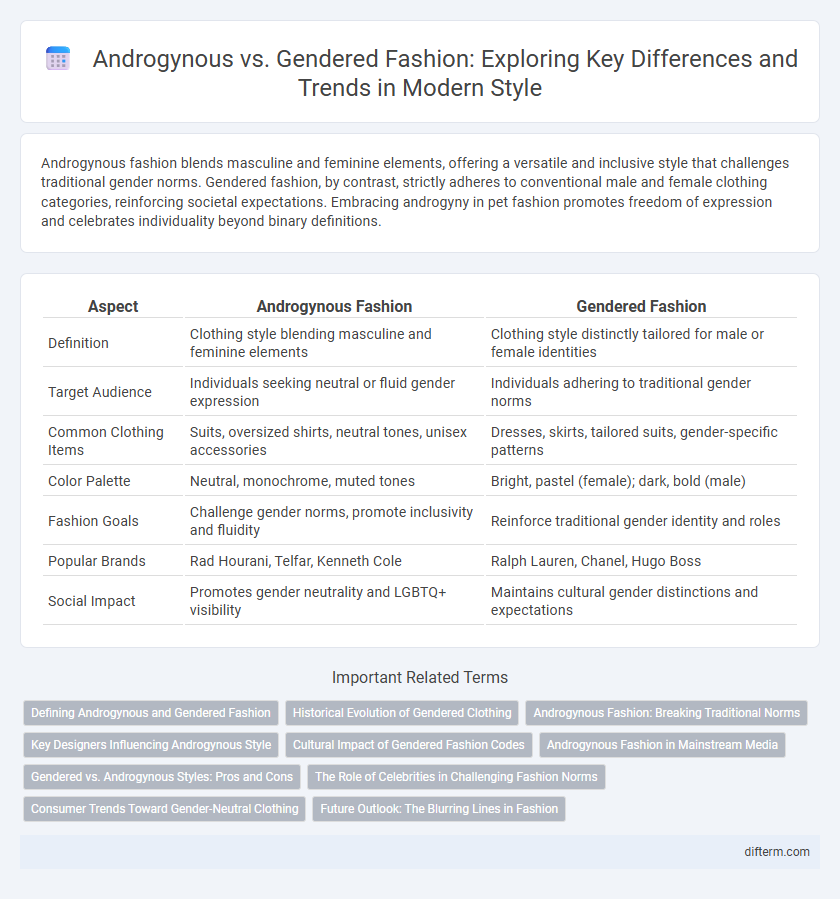Androgynous fashion blends masculine and feminine elements, offering a versatile and inclusive style that challenges traditional gender norms. Gendered fashion, by contrast, strictly adheres to conventional male and female clothing categories, reinforcing societal expectations. Embracing androgyny in pet fashion promotes freedom of expression and celebrates individuality beyond binary definitions.
Table of Comparison
| Aspect | Androgynous Fashion | Gendered Fashion |
|---|---|---|
| Definition | Clothing style blending masculine and feminine elements | Clothing style distinctly tailored for male or female identities |
| Target Audience | Individuals seeking neutral or fluid gender expression | Individuals adhering to traditional gender norms |
| Common Clothing Items | Suits, oversized shirts, neutral tones, unisex accessories | Dresses, skirts, tailored suits, gender-specific patterns |
| Color Palette | Neutral, monochrome, muted tones | Bright, pastel (female); dark, bold (male) |
| Fashion Goals | Challenge gender norms, promote inclusivity and fluidity | Reinforce traditional gender identity and roles |
| Popular Brands | Rad Hourani, Telfar, Kenneth Cole | Ralph Lauren, Chanel, Hugo Boss |
| Social Impact | Promotes gender neutrality and LGBTQ+ visibility | Maintains cultural gender distinctions and expectations |
Defining Androgynous and Gendered Fashion
Androgynous fashion blurs traditional gender distinctions by incorporating elements commonly associated with both masculine and feminine styles, emphasizing neutral silhouettes, unisex designs, and fluid expression. Gendered fashion adheres to conventional norms, distinctly separating clothing, colors, and accessories into male and female categories based on societal expectations. Understanding these definitions is crucial to appreciating the evolving landscape of personal identity and cultural representation in fashion.
Historical Evolution of Gendered Clothing
Gendered clothing has evolved significantly throughout history, reflecting societal norms and power structures from rigid Victorian corsets and tailored suits to the fluid styles of the 20th century. The industrial revolution and post-war eras reinforced strict gender roles through specific apparel, while contemporary fashion increasingly challenges these binaries by embracing androgyny. Designers like Yves Saint Laurent and Rei Kawakubo pioneered gender-neutral collections, blending masculine and feminine elements to blur traditional distinctions.
Androgynous Fashion: Breaking Traditional Norms
Androgynous fashion challenges traditional gender-specific clothing by blending masculine and feminine elements into versatile, inclusive styles. This trend emphasizes fluid silhouettes, neutral color palettes, and unisex pieces that empower self-expression beyond societal norms. Embracing androgyny fosters a progressive fashion culture that values individuality and diversity over rigid gender definitions.
Key Designers Influencing Androgynous Style
Key designers influencing androgynous fashion include Jean-Paul Gaultier, whose iconic use of tuxedo suits for women blurred traditional gender lines, and Rad Hourani, renowned for his gender-neutral collections that challenge binary fashion norms. Telfar Clemens revolutionized unisex style with inclusive designs promoting accessibility and self-expression beyond gender constraints. Designers like J.W. Anderson and Rei Kawakubo of Comme des Garcons continue to push androgyny forward by integrating fluid silhouettes and deconstructed tailoring into mainstream fashion.
Cultural Impact of Gendered Fashion Codes
Gendered fashion codes have historically reinforced cultural norms by assigning distinct styles and colors to men and women, influencing identity and social roles across societies. These codes often perpetuate gender stereotypes, limiting self-expression and maintaining traditional power structures through apparel expectations. The rise of androgynous fashion challenges these conventions, promoting inclusivity and questioning rigid cultural definitions of gender and beauty.
Androgynous Fashion in Mainstream Media
Androgynous fashion in mainstream media challenges traditional gender norms by promoting clothing styles that blend masculine and feminine elements, appealing to a broad audience. Celebrities like Harry Styles and Tilda Swinton often showcase androgynous looks, influencing designers and consumers to embrace gender-neutral aesthetics. This shift encourages inclusivity and diversity, reshaping industry standards and expanding opportunities for non-binary and gender-fluid representation.
Gendered vs. Androgynous Styles: Pros and Cons
Gendered fashion emphasizes distinct styles, colors, and cuts traditionally associated with male or female identities, boosting clarity in self-expression but often reinforcing stereotypes and limiting individual freedom. Androgynous fashion blends masculine and feminine elements, promoting inclusivity and versatility while sometimes facing social resistance or ambiguity in mainstream acceptance. Evaluating gendered vs. androgynous styles reveals a trade-off between cultural tradition and progressive identity fluidity in the fashion industry.
The Role of Celebrities in Challenging Fashion Norms
Celebrities play a pivotal role in challenging traditional fashion norms by embracing androgynous styles that blur gender lines, influencing mainstream acceptance and market trends. Figures like Harry Styles and Tilda Swinton showcase gender-fluid fashion on global platforms, prompting designers and brands to incorporate unisex collections that defy conventional male-female dichotomies. This increasing celebrity endorsement accelerates consumer openness towards diverse expressions of identity, reshaping the fashion industry's approach to gender.
Consumer Trends Toward Gender-Neutral Clothing
Consumer trends indicate a significant rise in demand for gender-neutral clothing, reflecting a shift from traditional androgynous or strictly gendered fashion categories. Brands increasingly prioritize versatile designs that appeal to a broader audience seeking inclusive, comfortable, and non-binary style options. Market research highlights a growing preference for adaptive fits, neutral color palettes, and unisex silhouettes that challenge conventional gender norms in fashion.
Future Outlook: The Blurring Lines in Fashion
The future of fashion trends shows a significant shift towards the blurring lines between androgynous and gendered clothing, emphasizing inclusive designs that cater to a diverse consumer base. Innovations in fabric technology and sustainable practices further support versatile wardrobes that transcend traditional gender norms. Market forecasts predict increased demand for gender-neutral collections from leading brands, signaling a transformative movement in retail fashion strategies.
Androgynous vs gendered fashion Infographic

 difterm.com
difterm.com